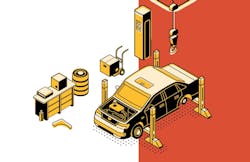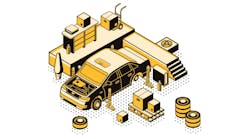Although a sufficient car count is vital to the success of a repair shop, more cars does not necessarily mean more money. A lower average repair order can quickly become the bottleneck to any shop, low car count or high.
This KPI becomes even more of an issue when car counts are higher than a shop is prepared for—employees are inspecting and repairing more cars than the shop’s capacity, but still not bringing in a high revenue. This scenario can quickly cause chaos, comebacks, disgruntled staff, and possibly can put a business on the brink of closing.
In order to maximize the car count that fits your staff and your shop proportionately, focus on increasing your average repair order. Multiple factors play into having a high ARO, including your customer base, the tools your team uses along the way and how services are recommended to clients.
The Right Customers
The Right Customers There is a huge difference between a customer who expects to only spend a few ten-dollar bills on an oil change and one who is willing to put in the investment to take care of their vehicle.
Which customer would you rather see drive through the doors of your shop?
At the end of the day, your shop doesn’t have time for everyone. And your team needs to be able to spend their quality time and effort on customers who value what you provide.
Keep in mind, a flood of discount customers will inevitably result in a flood of low repair orders, bogging down your shop with extra work and no pay off.
To bring in the right customers (and deter those only interested in low cost or a single service) pricing should be increased and the marketing audience should be shifted. This switch will attract new customers who value both quality service and investing in their vehicle.
Target your marketing efforts to the customer demographics that mirror your top, value-oriented customers in order to bring in more of the same. Raising the labor rate at your shop can also aid in weeding the customers unwilling to look into further repairs beyond an oil change.
Best Tool for the Job
The secret behind almost all shops with impressively high AROs is the correct use of a digital vehicle inspection tool.
A courtesy digital inspection should be done on every single vehicle that comes into the shop, and at the beginning of the process, to come up with a complete vehicle health report from the start. When performing a digital inspection, technicians should take 15 to 20 clear pictures, including parts of the vehicle that don’t need repair at the time. This way, customers can compare pictures when they come back in and can see the parts changing overtime. On the photos of the parts that do need to be repaired, technicians should be encouraged to draw circles or arrows on the photos that make it easier for the customer to understand. Short videos showcasing something moving (or not moving) correctly can also be useful when completing a digital inspection.
Some customers may have previous car and repair knowledge, but most don’t—digital inspections act as visual proof of the services that should be taken care of in their vehicle. With photographic evidence, customers are more willing to trust the technician’s judgement and get the recommended repair—raising the shop’s overall ARO.
Increase Your ARO Today
—
Don’t rush through inspections. Slow it down a bit to make sure you capture all opportunities and repairs. Cutting corners means cutting opportunities.
Include notes along with DVI photos and use the report as an opportunity to educate customers.
Include pictures of both bad and good items found during a DVI. By showing the good and the bad, you create an unbiased, credible, overall vehicle health report instead of a list of problems that could scare the customer.
Be sure to upsell small, yet high margin services, such as new wipers on rainy days. This is a super easy conversation to have with a customer but often overlooked.
Don’t let the customer leave without setting their next appointment. Use digital tools to send appointment reminders.
When the customer drops off their vehicle, be sure to remind them of past recommendations that were postponed during the previous visit. Use the DVI photos to show the history and evidence to reinforce why it’s time to get it done now.



